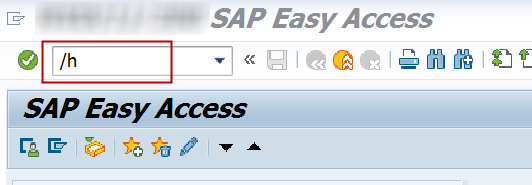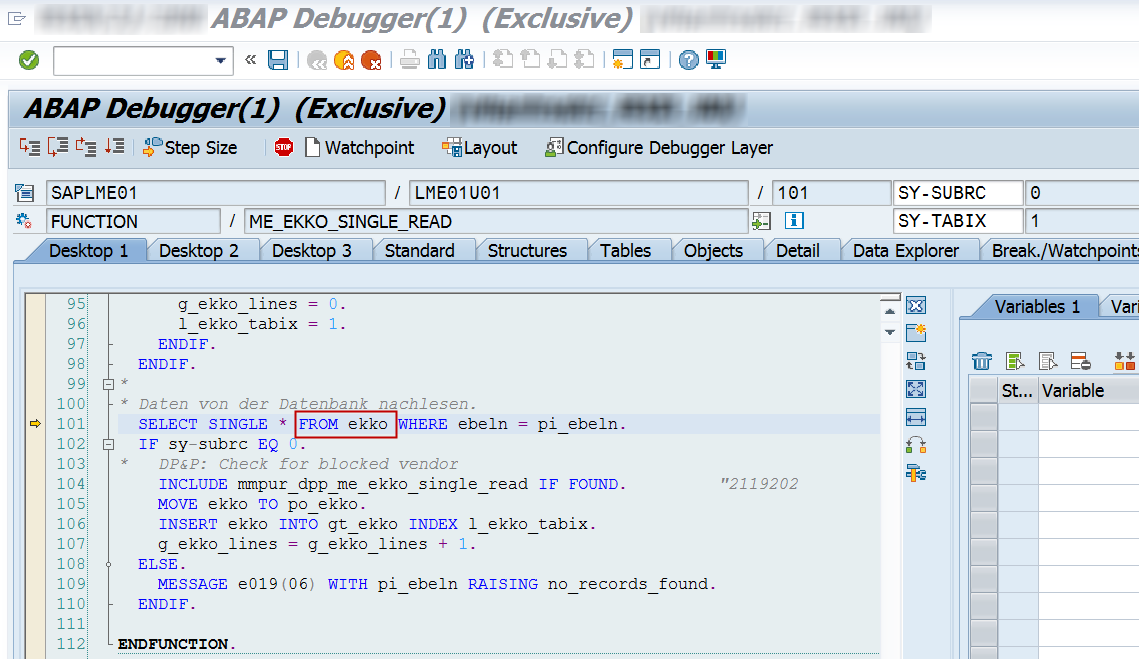
- SAP Community
- Groups
- Interest Groups
- Application Development
- Blog Posts
- Break point for SELECT statement with Table Filter
Application Development Blog Posts
Learn and share on deeper, cross technology development topics such as integration and connectivity, automation, cloud extensibility, developing at scale, and security.
Turn on suggestions
Auto-suggest helps you quickly narrow down your search results by suggesting possible matches as you type.
Showing results for
SAP Community Downtime Scheduled for This Weekend
SAP Community will be read-only this weekend (Saturday, August 31, through Sunday, September 1). Activities requiring log-in won't be possible. Learn more in this What's New post.
former_member18
Explorer
Options
- Subscribe to RSS Feed
- Mark as New
- Mark as Read
- Bookmark
- Subscribe
- Printer Friendly Page
- Report Inappropriate Content
07-25-2019
1:18 PM
13,075
- SAP Managed Tags:
- ABAP Development,
- ABAP Testing and Analysis
1. OVERVIEW
In some occasions we need to find exactly where a SELECT statement is done for a particular table.
We can use breakpoint for SELECT statement but, most probably, the debugging session can be hard due to the number of hits we can get.
We can use some traces transaction like ST05 or ST12, but we need to switch ON/OFF the trace and then analyse the result.
To go straight forward and find exactly the place in the code where table, or a group of them, are being involved in a SELECT statement we can use Filter Criteria for the Breakpoint.
2. TEST CASE
Imagine that we want to identify where tables EKKO and EKPO are being selected during execution of Transaction Code ME23N - Display Purchase Order
Start a debugging session:

Press ENTER:

Run TCode ME23N and press ENTER:

Just after debugging environment is available, create a Breakpoint for SELECT statement:


Now go to “Break./Watchpoints” tab:

Select the line for Breakpoint created and press “Define Filter”:

Select RSTPDA_SCRIPT_BP_SQL_DBTAB filter option:

Now write the table you want to focus on:

Actually this is a Select Options, so you can decided the tables as you wish:

Then, accept the selection criteria. You can decide to save the breakpoint but although breakpoint will be available for next run the filter is removed so just put it back if you need to debug again:

Go to Desktop 1 tab:

Press F8 … Hit for EKKO reached!

Press F8… again another EKKO selection:

Now EKPO hit!:

And another EKPO selection found!:

3. CONCLUSION
We can save much time to find out where a particular table is used in a SELECT statement or where to develop an enhancement after the SELECT.
Finally mention that his approach is also working when SELECT statement is built with dynamic table name:
https://help.sap.com/viewer/cfae740a0a21455dbe6e510c2d86e36a/7.3.19/en-US/fceb39c4358411d1829f0000e8...

Alfonso Rodríguez Pérez.
SAP ABAP Consultant.
In some occasions we need to find exactly where a SELECT statement is done for a particular table.
We can use breakpoint for SELECT statement but, most probably, the debugging session can be hard due to the number of hits we can get.
We can use some traces transaction like ST05 or ST12, but we need to switch ON/OFF the trace and then analyse the result.
To go straight forward and find exactly the place in the code where table, or a group of them, are being involved in a SELECT statement we can use Filter Criteria for the Breakpoint.
2. TEST CASE
Imagine that we want to identify where tables EKKO and EKPO are being selected during execution of Transaction Code ME23N - Display Purchase Order
Start a debugging session:

Press ENTER:

Run TCode ME23N and press ENTER:

Just after debugging environment is available, create a Breakpoint for SELECT statement:


Now go to “Break./Watchpoints” tab:

Select the line for Breakpoint created and press “Define Filter”:

Select RSTPDA_SCRIPT_BP_SQL_DBTAB filter option:

Now write the table you want to focus on:

Actually this is a Select Options, so you can decided the tables as you wish:

Then, accept the selection criteria. You can decide to save the breakpoint but although breakpoint will be available for next run the filter is removed so just put it back if you need to debug again:

Go to Desktop 1 tab:

Press F8 … Hit for EKKO reached!

Press F8… again another EKKO selection:

Now EKPO hit!:

And another EKPO selection found!:

3. CONCLUSION
We can save much time to find out where a particular table is used in a SELECT statement or where to develop an enhancement after the SELECT.
Finally mention that his approach is also working when SELECT statement is built with dynamic table name:
https://help.sap.com/viewer/cfae740a0a21455dbe6e510c2d86e36a/7.3.19/en-US/fceb39c4358411d1829f0000e8...

Alfonso Rodríguez Pérez.
SAP ABAP Consultant.
18 Comments
You must be a registered user to add a comment. If you've already registered, sign in. Otherwise, register and sign in.
Labels in this area
-
- SAP
1 -
A Dynamic Memory Allocation Tool
1 -
A Unit Test for function Module
1 -
ABAP
15 -
ABAP 7.4
4 -
ABAP API
1 -
abap cds
2 -
ABAP CDS VIEW
1 -
ABAP CDS Views
14 -
ABAP class
1 -
ABAP Cloud
1 -
ABAP Development
7 -
ABAP Environment & RAP
1 -
abap for sap hana
1 -
ABAP in Eclipse
2 -
ABAP Keyword Documentation
2 -
ABAP OOABAP
3 -
ABAP Programming
2 -
ABAP RESTFul API
2 -
ABAP RESTful Application Programming Model
1 -
abap technical
1 -
ABAP test cockpit
7 -
ABAP test cokpit
1 -
adobe form
1 -
ADT
1 -
Advanced Event Mesh
1 -
AEM
2 -
AI
1 -
AL11
1 -
ALV
1 -
alv oo
1 -
API and Integration
2 -
APIs
22 -
APIs ABAP
1 -
App Dev and Integration
2 -
Application Development
2 -
application job
1 -
archivelinks
1 -
aRFC
1 -
AUNIT
2 -
authorization
1 -
Automatic PO during Goods Receipt
1 -
Automation
11 -
B2B Integration
1 -
BADI
1 -
Batch Management
1 -
BTP
1 -
BTP Destination
1 -
buffer
1 -
Business Application Studio
1 -
Business objects
1 -
Business Technology Platform
1 -
cache
1 -
CAP
4 -
CAP CDS
1 -
CAP development
2 -
CAPM
1 -
Career Development
10 -
CDS Access Control
1 -
CL_GUI_FRONTEND_SERVICES
1 -
cl_gui_html_viewer
1 -
CL_SALV_TABLE
2 -
Clean Core
1 -
Cloud Extensibility
14 -
Cloud Native
13 -
Cloud Platform Integration
1 -
CloudEvents
2 -
CMIS
1 -
coding
1 -
Connection
1 -
container
1 -
Customer Experience
1 -
Customer Portal
1 -
CVA
1 -
Debugging
2 -
developer challenge
1 -
Developer extensibility
1 -
Developing at Scale
9 -
DMS
1 -
download
1 -
dynamic logpoints
1 -
Dynpro
1 -
Dynpro Width
1 -
Eclipse ADT ABAP Development Tools
1 -
EDA
1 -
EML Operation In RAP
1 -
Event Mesh
1 -
Events
1 -
Excel
2 -
Expert
1 -
export
1 -
Extending standard Odata service
1 -
Field Symbols in ABAP
1 -
Figma
1 -
Fiori
1 -
Fiori App Extension
1 -
Forms & Templates
1 -
Function module
1 -
General
1 -
Getting Started
1 -
GitHub
1 -
Google Chrome
1 -
grid table
1 -
HTML Container
1 -
IBM watsonx
3 -
Integration
1 -
Integration & Connectivity
25 -
Introduction
1 -
JavaScript
1 -
JavaScripts used by Adobe Forms
1 -
joule
1 -
Keeping the core clean
1 -
Kubernetes
1 -
logic programming
1 -
Monitor Message Processing
1 -
MR11
1 -
NodeJS
1 -
ODATA
3 -
OOABAP
4 -
open sql
1 -
Outbound queue
1 -
paste
1 -
Performance
1 -
pipeline
1 -
ProCustomer
1 -
Product Updates
1 -
programming
1 -
Programming Models
26 -
qRFC
1 -
RAP
2 -
React
1 -
React and CAP App – Deployed in BTP
1 -
READ_TEXT
1 -
Recursion in ABAP
1 -
responsive table
1 -
Restful webservices Using POST MAN
1 -
RFC
2 -
RFFOEDI1
1 -
RISE with SAP Methodology
1 -
sap abap
1 -
SAP BAS
1 -
SAP BTP
2 -
SAP BTP Integration Suite
1 -
SAP Build
1 -
SAP Build Apps
1 -
SAP Build CodeJam
1 -
SAP CodeTalk
1 -
SAP Odata
2 -
SAP SEGW
1 -
SAP Tech Bytes
1 -
SAP UI5
1 -
SAP UI5 Custom Library
1 -
SAPEnhancements
1 -
SapMachine
1 -
search help
1 -
Search help exit
1 -
Security
4 -
SM30
1 -
SM58
1 -
SMQ1
1 -
SMQ2
1 -
SQLite
1 -
sRFC
1 -
table
1 -
Table Maintenance Generator
1 -
Test double framework
1 -
Testing Environment
1 -
text editor
1 -
Time Optimization
1 -
Tools
32 -
translation
1 -
tRFC
1 -
typescript
1 -
Unmanaged scenario in RAP
1 -
usability
1 -
User Experience
12 -
web development
1 -
webview
1 -
webview2
1 -
Width
1
- « Previous
- Next »
Top kudoed authors
| User | Count |
|---|---|
| 6 | |
| 3 | |
| 3 | |
| 3 | |
| 3 | |
| 3 | |
| 2 | |
| 2 | |
| 1 | |
| 1 |